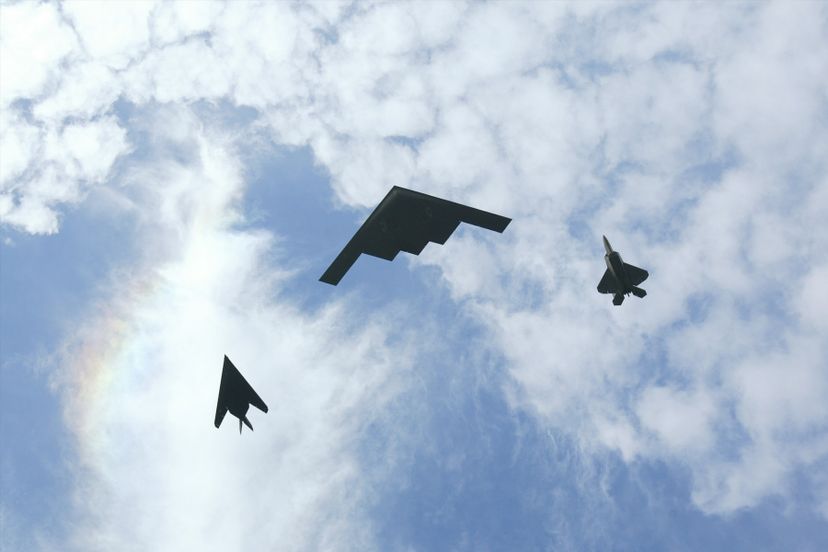
About This Quiz
Aircraft have been part of military tactics and strategy since before airplanes were invented. During the mid-nineteenth century, military balloons were used for surveillance of surrounding territories. Â
Air superiority has been an important part of military engagement ever since. From balloons to drones, the ability to see and fight from high above the earth has given nations with the best aircraft the best chance at winning wars.
Some advances in aircraft technology make sense--like the development of planes that are difficult to see on radar. But other advances, like that of the Douglas SBD Dauntless, a dive-bomber whose wings look like Swiss cheese, are more remarkable for their ingenuity.Â
Do you consider yourself an aircraft know-it-all? Do you know which airplane is the largest in the world? Can you name the volunteer pilot group that popularized aircraft nose art? Take this quiz to see how much you know about aircraft history and technology. We're sure you'll pass with flying colors!
The Harrier Jump Jet was developed to take off and land in small spaces, without a long runway.
The P-38's twin tails gave it very stable aerodynamics, but it was not the most agile plane. It excelled as a heavy fighter and in fighter/bomber missions.
The Flying Tigers were a volunteer group of U.S. pilots that fought in China against Japan. The shark mouth insignia on their airplanes was (and still is) the most iconic nose art in the world.
Advertisement
The pilot named the Enola Gay for his mother, Enola Gay Tibbets. The airplane is on display at the Smithsonian's National Air and Space Museum annex at Dulles International Airport.
More than 20,000 Supermarine Spitfires were produced. The plane was instrumental in the Battle of Britain.
With its 30 mm chain gun and Hellfire missiles, the Apache is a formidable attack helicopter.
Advertisement
Allied forces developed codenames for Japanese aircraft because the Japanese designations were complicated and hard to differentiate. The official codename for the Zero was Zeke.
Ones of the B-17s used in the movie is still flown today with the Memphis Belle name. The real Memphis Belle that inspired the movie is now on display at the National Museum of the United States Airforce.
The B-52s 70,000-pound capacity, performance and upgradability have allowed it to remain in service for more than 60 years.
Advertisement
Stealth aircraft are designed to have radar signatures far smaller than their actual size and to diffuse and mask the thermal output of the engines.
Manfred von Richthofen flew several different types of aircraft during World War I, but the distinctive look of the Dr.I's three wings made it more notorious than the others.
When Snoopy pretends to be a World War I flying ace, he flies an imaginary Sopwith Camel.
Advertisement
Its ungainly appearance earned the A-10 the Warthog nickname. There were 716 of these built, and they're still in use today.
The Messerschmitt Me 262 was probably the most advanced plane of World War II, but because it was an example of a piece of cutting edge of technology, that made it complicated and difficult to maintain.
Goose, Maverick and Iceman flew F-14 Tomcats. Over 700 of them were built.
Advertisement
Hueys played a number of roles in Vietnam, including assault missions and medical evacuation of troops.
The An-225 is larger and heavier than any other plane in the world. Only one was built, although it's currently in commercial service and no longer a military plane. It is almost six stories tall.
The F-117 Nighthawk first saw action in Panama in 1989. As of 2016, the U.S. is the only nation to have used stealth aircraft in combat.
Advertisement
F-4 Phantom IIs and MiG-21s engaged in many duels in the skies above Vietnam. The U.S. ended their involvement with the war in 1973.
The Yakovlev Yak-3 was a small, light but extremely agile fighter deployed by Soviet forces in World War II.
Nearly 4,000 Gloster Meteors were built, entering service in 1944. They were officially retired in the 1980s, after serving a second life as Royal Air Force target tugs.
Advertisement
The idea of powering the XB-70 with a nuclear reactor was abandoned when it became clear how costly and potentially disastrous it would be.
The F-22 Raptor was literally too good. The more versatile F-35 will be the primary fighter for the U.S. military instead in the coming decades.
The Union had a balloon corps that performed mapping and observation duties in the Civil War.
Advertisement
The Ho 229 was a flying wing, a plane with no fuselage. Only three of them were ever built and used by the Luftwaffe.
The Soviets put over 36,000 Sturmoviks in the air during the war. They are a type of ground-attack aircraft.
The Eurofighter Typhoon was designed and built via a multi-nation effort. Several Middle Eastern nations are also using it.
Advertisement
Stealth technology wasn't really a consideration when the Vulcan was designed in the 1950s, but its sleek design with enclosed engines and a low-profile fuselage made it more difficult to detect on radar than almost any other aircraft of its era.
The Waco was a combat glider, towed behind a C-47. It had no engine of its own.
The Lockheed SR-71 Blackbird set the official record of 2,193 mph in 1976.
Advertisement